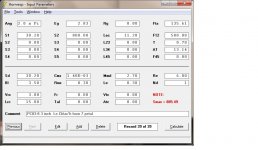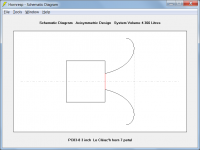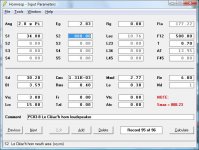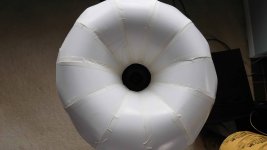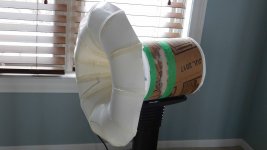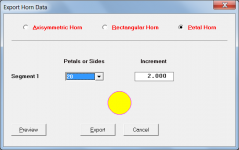No problem. Keep in mind the throat opening is for a PC83-8 which has Sd=30cm^2. Yours is probably different. I plot the hornresp csv export with numbered axis (cm) to check the dimensions after printing.
Attachments
Hi DonVK,
Many thanks for posting the pictures, it is reassuring to see that the Hornresp calculations appear to give the correct profile. I have never actually built a petal horn myself to check .
.
I guess you had a good reason not to construct the Le Cléac'h horn with a full 180 degree roll-back at the mouth?
(To do so would simply have required S2 to be set to the given Smax value of 885.49).
It would be interesting to know if it is any more difficult folding and fitting the petals making up a fully-formed 180 degree horn.
Kind regards,
David
Many thanks for posting the pictures, it is reassuring to see that the Hornresp calculations appear to give the correct profile. I have never actually built a petal horn myself to check
I guess you had a good reason not to construct the Le Cléac'h horn with a full 180 degree roll-back at the mouth?
(To do so would simply have required S2 to be set to the given Smax value of 885.49).
It would be interesting to know if it is any more difficult folding and fitting the petals making up a fully-formed 180 degree horn.
Kind regards,
David
Attachments
Hi David,
I am currently building a very large 12 petal 112 degree Le Cle'ac'h horn, and it is difficult but not impossible. It is essential that both sides of each petal are perfectly mirrored, otherwise anomalies of alignment start to creep in at the extremes of the curve. My next build will be a 180 degree version - most probably 16 petals, but to really make it work, I would prefer 32!
I know that Hornresp has a present limit of 20, and I have been wondering a lot lately if it would be possible to incorporate such a suggestion?
Kindness from tapestryofsound
I am currently building a very large 12 petal 112 degree Le Cle'ac'h horn, and it is difficult but not impossible. It is essential that both sides of each petal are perfectly mirrored, otherwise anomalies of alignment start to creep in at the extremes of the curve. My next build will be a 180 degree version - most probably 16 petals, but to really make it work, I would prefer 32!
I know that Hornresp has a present limit of 20, and I have been wondering a lot lately if it would be possible to incorporate such a suggestion?
Kindness from tapestryofsound
Hi DonVK,
Many thanks for posting the pictures, it is reassuring to see that the Hornresp calculations appear to give the correct profile. I have never actually built a petal horn myself to check.
I guess you had a good reason not to construct the Le Cléac'h horn with a full 180 degree roll-back at the mouth?
(To do so would simply have required S2 to be set to the given Smax value of 885.49).
It would be interesting to know if it is any more difficult folding and fitting the petals making up a fully-formed 180 degree horn.
Kind regards,
David
The first 7-petal design was a trial run. I was resurrecting an old inkjet printer and trying to fit a petal 1:1 on a single A sheet (8.5x11).
I retried another horn using an 11-petal design and increased the mouth area to get a fuller roll over as you suggested. I also increased the throat a little more to better match the driver. The rollover assembly is more difficult from bending and accumulated assembly error
Attachments
Hi tapestryofsound,
Many thanks for the feedback on the difficulty of construction.
Are the anomalies due to inaccuracies in the Hornresp data, or are they due to the difficulty in lining everything up when assembling the horn?
Historically petal horns seem to have had an odd number of panels - I guess to minimise the possibility of lateral resonances between parallel walls.
I chose 20 petals as the limit because by then the horn cross-section is effectively circular (see attachment). Also, with more than about 11 petals assembly could become quite difficult. There is no practical reason though, why the limit could not be lifted higher if so required.
Kind regards,
David
I am currently building a very large 12 petal 112 degree Le Cle'ac'h horn, and it is difficult but not impossible.
Many thanks for the feedback on the difficulty of construction.
It is essential that both sides of each petal are perfectly mirrored, otherwise anomalies of alignment start to creep in at the extremes of the curve.
Are the anomalies due to inaccuracies in the Hornresp data, or are they due to the difficulty in lining everything up when assembling the horn?
My next build will be a 180 degree version - most probably 16 petals, but to really make it work, I would prefer 32!
Historically petal horns seem to have had an odd number of panels - I guess to minimise the possibility of lateral resonances between parallel walls.
I know that Hornresp has a present limit of 20, and I have been wondering a lot lately if it would be possible to incorporate such a suggestion?
I chose 20 petals as the limit because by then the horn cross-section is effectively circular (see attachment). Also, with more than about 11 petals assembly could become quite difficult. There is no practical reason though, why the limit could not be lifted higher if so required.
Kind regards,
David
Attachments
I retried another horn using an 11-petal design and increased the mouth area to get a fuller roll over as you suggested. I also increased the throat a little more to better match the driver. The rollover assembly is more difficult from bending and accumulated assembly error(more pieces). It's an improvement, the measurements are at Dayton PC83-8 (3") test results with the rest of the PC83-8 collection.
Hi DonVK,
Excellent! Many thanks for doing this, it's all great feedback.
Kind regards,
David
QUOTE:-Hi tapestryofsound,
Many thanks for the feedback on the difficulty of construction.
And in return, I thank you for your thoughtful reply
QUOTE:- Are the anomalies due to inaccuracies in the Hornresp data, or are they due to the difficulty in lining everything up when assembling the horn?
Take it as given that the Hornresp data is both credible and accurate. The problem lies in draughting the temporary paper template used for making the master petal template for creating an identical set of petals. I realise now that it is essential to make sure that each point on either side is an identical distance from the middle. This is easily done by folding the temporary template in half and marking each point from edge to centreline - very much like a child cutting random shapes from a folded piece of paper to make a symmetrical snowflake. In other words, it is all doable
QUOTE:- Historically petal horns seem to have had an odd number of panels - I guess to minimise the possibility of lateral resonances between parallel walls.
Yes, I have wondered about this ..... it makes sense with any of the other wave guides - except (and correct me if I am wrong!) the Le Cle'ac'h, which is continuously expanding from the beginning of the throat, all the way up to, and finally around the edge of the puckered lip of the mouth. My instincts tell me the Le Cle'ac'h is -the- perfect wave guide to concentrate my attentions upon.
QUOTE:- I chose 20 petals as the limit because by then the horn cross-section is effectively circular (see attachment). Also, with more than about 11 petals assembly could become quite difficult. There is no practical reason though, why the limit could not be lifted higher if so required.
Yes, a first time assembly with 11 or more petals is certainly difficult, but thereafter, it all becomes a lot easier. It is like coopering a wooden barrel, daunting until seeing a master cooper at work who makes it all look effortless.
Eventually, I will make a floor standing Le Cle'ac'h horn with a swan neck - I reckon it is doable, and the more petals the better - certainly for making complex bends and curves in individual petals. And to do this requires an accuracy of plus or minus 0.5mm per metre. With 32 petals I am completely convinced it can be done!
Kindness tapestryofsound.
Many thanks for the feedback on the difficulty of construction.
And in return, I thank you for your thoughtful reply
QUOTE:- Are the anomalies due to inaccuracies in the Hornresp data, or are they due to the difficulty in lining everything up when assembling the horn?
Take it as given that the Hornresp data is both credible and accurate. The problem lies in draughting the temporary paper template used for making the master petal template for creating an identical set of petals. I realise now that it is essential to make sure that each point on either side is an identical distance from the middle. This is easily done by folding the temporary template in half and marking each point from edge to centreline - very much like a child cutting random shapes from a folded piece of paper to make a symmetrical snowflake. In other words, it is all doable
QUOTE:- Historically petal horns seem to have had an odd number of panels - I guess to minimise the possibility of lateral resonances between parallel walls.
Yes, I have wondered about this ..... it makes sense with any of the other wave guides - except (and correct me if I am wrong!) the Le Cle'ac'h, which is continuously expanding from the beginning of the throat, all the way up to, and finally around the edge of the puckered lip of the mouth. My instincts tell me the Le Cle'ac'h is -the- perfect wave guide to concentrate my attentions upon.
QUOTE:- I chose 20 petals as the limit because by then the horn cross-section is effectively circular (see attachment). Also, with more than about 11 petals assembly could become quite difficult. There is no practical reason though, why the limit could not be lifted higher if so required.
Yes, a first time assembly with 11 or more petals is certainly difficult, but thereafter, it all becomes a lot easier. It is like coopering a wooden barrel, daunting until seeing a master cooper at work who makes it all look effortless.
Eventually, I will make a floor standing Le Cle'ac'h horn with a swan neck - I reckon it is doable, and the more petals the better - certainly for making complex bends and curves in individual petals. And to do this requires an accuracy of plus or minus 0.5mm per metre. With 32 petals I am completely convinced it can be done!
Kindness tapestryofsound.
petal reinforcing method
I just wanted to add a construction method that I recently tried that was fast and effectively stiffens the horn structure. It's painted on wax ala @Silverprout but cheap (dollar store) garden fabric strips immediately applied to the back and wax'ed over to form a composite like mache.
It did not make an acoustic performance difference for my 11-petal at Dayton PC83-8 (3") test results but it is significantly stronger.
I just wanted to add a construction method that I recently tried that was fast and effectively stiffens the horn structure. It's painted on wax ala @Silverprout but cheap (dollar store) garden fabric strips immediately applied to the back and wax'ed over to form a composite like mache.
It did not make an acoustic performance difference for my 11-petal at Dayton PC83-8 (3") test results but it is significantly stronger.
Last edited:
Hi tapestryofsound,
Excellent, thanks for the confirmation. I was hoping that the Hornresp data would be correct, but you can never be sure... .
.
That's why the petal "Y-axis" dimension is given as Width / 2 rather than Width, so that you don't have to divide the calculated values by two .
.
The Hornresp petal dimensions assume a straight-axis horn with all petals of the same length. Won't you run into problems if you want to bend the horn, with the petals on the outside of the fold needing to be longer than those on the inside?
Kind regards,
David
Take it as given that the Hornresp data is both credible and accurate.
Excellent, thanks for the confirmation. I was hoping that the Hornresp data would be correct, but you can never be sure...
I realise now that it is essential to make sure that each point on either side is an identical distance from the middle.
That's why the petal "Y-axis" dimension is given as Width / 2 rather than Width, so that you don't have to divide the calculated values by two
Eventually, I will make a floor standing Le Cle'ac'h horn with a swan neck - I reckon it is doable, and the more petals the better - certainly for making complex bends and curves in individual petals. And to do this requires an accuracy of plus or minus 0.5mm per metre. With 32 petals I am completely convinced it can be done!
The Hornresp petal dimensions assume a straight-axis horn with all petals of the same length. Won't you run into problems if you want to bend the horn, with the petals on the outside of the fold needing to be longer than those on the inside?
Kind regards,
David
Things are sent to try us
Hi David,
I have been thinking about the exact same thing for months........and agree entirely with what you say........and still continue to think about it
Let me tell an illustrative story.
Many years ago, I watched some local Chinese lads flying a dragon kite from a fixed mooring. These kites are big, and start at the front with the dragon's head followed by a series of wooden hoops covered in tissue paper, each centred by a crossed pair of spars on a line nearly 100 feet long with intervals of about 2 feet between each hoop. I counted fifty discs, starting at the head at around 4 feet in diameter, and ending at the tail about 6 inches in diameter. Each of the horizontal spars had twinned drag spoilers on them made of silk tassels to help stop any spiralling motion. The X and Y axis points of the crosspars on each hoop were connected by twines along the entire length of the kite.
The result was extraordinary. The dragon undulated up and down and from side to side - just like what you would see in a Studio Ghibli animation. I stood mesmerised and enchanted for nearly an hour watching. What really impressed me was no matter how much the kite got hammered by the wind, none of the hoops ever actually hit each other. It was something I have never forgotten, and of late it keeps on reappearing within my minds eye whenever I think about my build.
So - I reckon that if I build a scale model of the Le Cle'ac'h horn with say, 16 (or even 32!) faceted discs on a line emulating a swan neck curve, I could model and transfer the points to a corresponding set of petals that could be then be cut and fashioned together
Kindness tapestryofsound
The Hornresp petal dimensions assume a straight-axis horn with all petals of the same length. Won't you run into problems if you want to bend the horn, with the petals on the outside of the fold needing to be longer than those on the inside?
Hi David,
I have been thinking about the exact same thing for months........and agree entirely with what you say........and still continue to think about it
Let me tell an illustrative story.
Many years ago, I watched some local Chinese lads flying a dragon kite from a fixed mooring. These kites are big, and start at the front with the dragon's head followed by a series of wooden hoops covered in tissue paper, each centred by a crossed pair of spars on a line nearly 100 feet long with intervals of about 2 feet between each hoop. I counted fifty discs, starting at the head at around 4 feet in diameter, and ending at the tail about 6 inches in diameter. Each of the horizontal spars had twinned drag spoilers on them made of silk tassels to help stop any spiralling motion. The X and Y axis points of the crosspars on each hoop were connected by twines along the entire length of the kite.
The result was extraordinary. The dragon undulated up and down and from side to side - just like what you would see in a Studio Ghibli animation. I stood mesmerised and enchanted for nearly an hour watching. What really impressed me was no matter how much the kite got hammered by the wind, none of the hoops ever actually hit each other. It was something I have never forgotten, and of late it keeps on reappearing within my minds eye whenever I think about my build.
So - I reckon that if I build a scale model of the Le Cle'ac'h horn with say, 16 (or even 32!) faceted discs on a line emulating a swan neck curve, I could model and transfer the points to a corresponding set of petals that could be then be cut and fashioned together
Kindness tapestryofsound
I reckon that if I build a scale model of the Le Cle'ac'h horn with say, 16 (or even 32!) faceted discs on a line emulating a swan neck curve, I could model and transfer the points to a corresponding set of petals that could be then be cut and fashioned together
Hi tapestryofsound,
It appears that you are setting yourself quite a challenge
I know what you mean about Chinese dragon kites - they are indeed fascinating to watch, even when flying in the lightest of breezes.
Kind regards,
David
I think if you are going to that much trouble with the discs, you no longer need the petal aspect - just put paper mache (or plaster, or whatever) over the discs, to connect them up.So - I reckon that if I build a scale model of the Le Cle'ac'h horn with say, 16 (or even 32!) faceted discs on a line emulating a swan neck curve, I could model and transfer the points to a corresponding set of petals that could be then be cut and fashioned together
The pictures in post 17 are an example. This horn was terrible, acoustically, but the construction was OK, and would go much faster with a cardboard frame.
Fostex FF105WK in conical horn
I think if you are going to that much trouble with the discs, you no longer need the petal aspect - just put paper mache (or plaster, or whatever) over the discs, to connect them up.
The pictures in post 17 are an example. This horn was terrible, acoustically, but the construction was OK, and would go much faster with a cardboard frame.
Fostex FF105WK in conical horn
Hi hollowboy,
I read the thread and looked at the pictures. In principle, I agree with you, but I still want a petal speaker to look like a petal speaker - or preferably, a flower or a sea creature. What I really like about front loaded petal horn speakers is that they wear their mathematics on the outside, as expressed by the physical tension holding the petals together. To me, a good petal horn speaker should sound wonderful (of course!) and look like it is about to explode.
The frame is a good idea, eminently practical, but not challenging enough for me
Kindness tapestryofsound
- Status
- This old topic is closed. If you want to reopen this topic, contact a moderator using the "Report Post" button.
- Home
- Design & Build
- Construction Tips
- Paper Horn constuction
